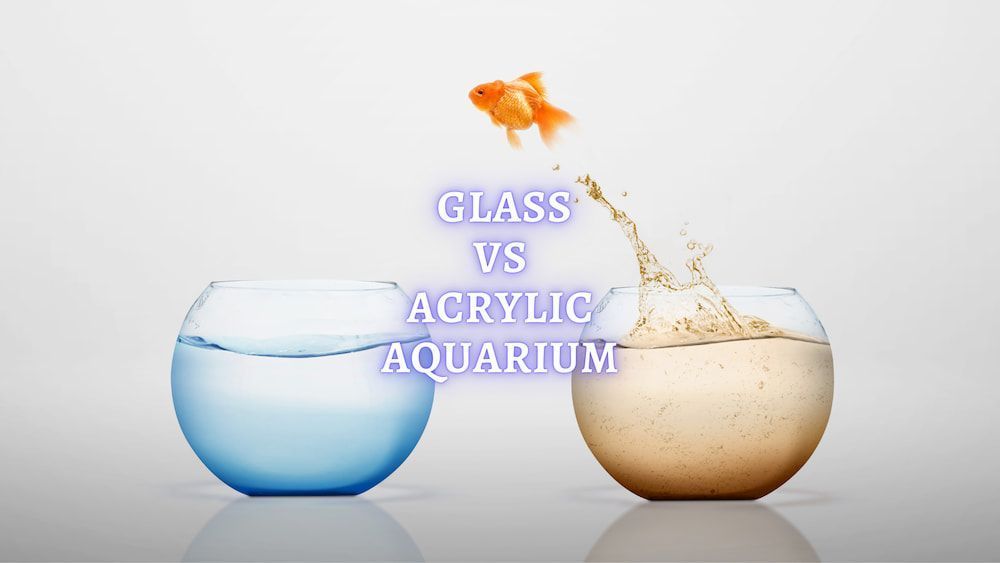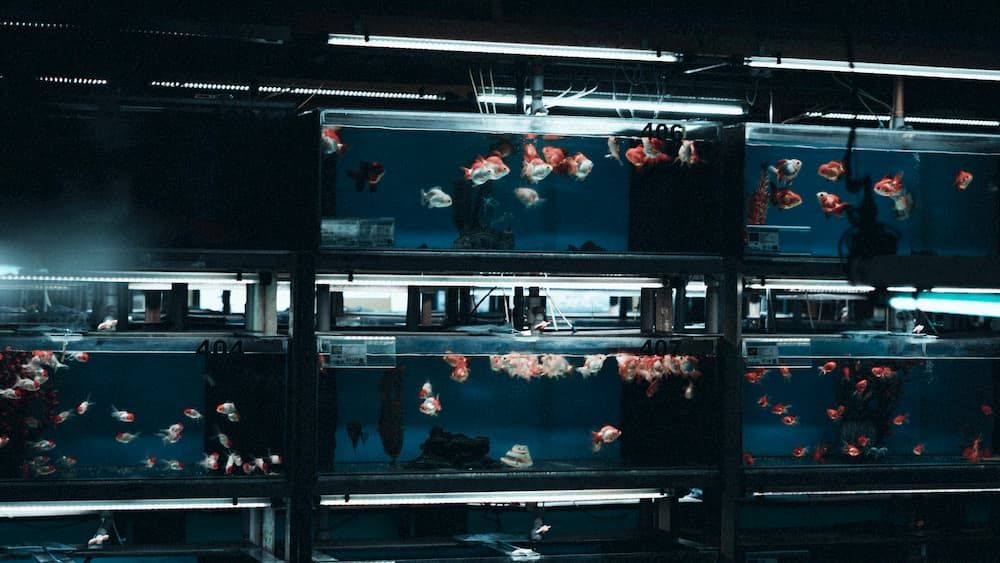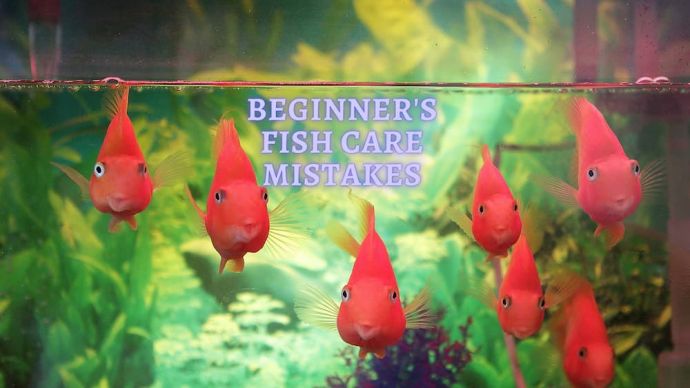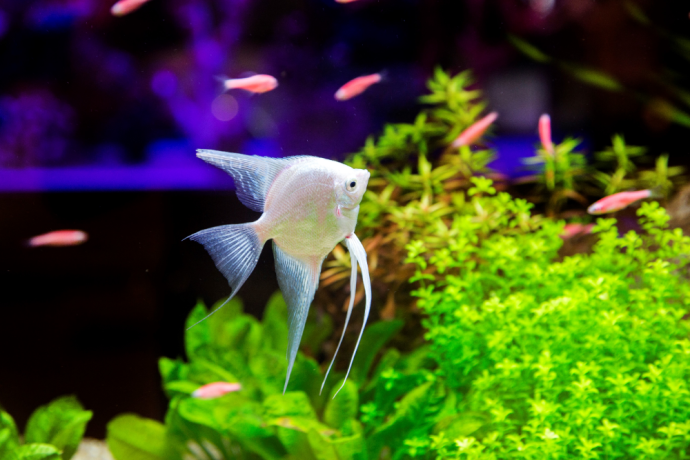Glass vs Acrylic Aquarium: Which Fish Tank is Best for you?
Written by:
Author: Alina Andreeva
Alina A. is a professional writer, editor, and pet-lover. She has published over 50 articles on how to care for pets properly. Alina has been writing articles for 3 years, so she has considerable experience in this niche. Her natural curiosity helps her to expand her knowledge and learn new pet care life hacks, which will make your life much easier.
View all 79 articlesLearn about our editorial process and veterinary review board.
Viewed: 229
Updated on: 01/06/2023
According to the American Pet Products Association’s Pet Owners Survey, 13.1 million U.S. households have pet fish. [1] If you feel the waters’ call too and want to have a little slice of aquatic nature at home, you have two options: glass or acrylic. However, many beginning fish hobbyists don’t know the difference between them – except that an acrylic tank tends to have a much more costly price tag. This may give the impression that an acrylic aquarium is better, but this is not always true. Both fish tank materials have their own pros and cons.
Acrylic vs. Glass Aquarium Features:
| Features | Glass | Acrylic |
| Scratch-Resistant | Yes | – |
| Lightweight | – | Yes |
| Shatterproof | – | Yes |
| Doesn’t Distort Light | – | Yes |
| Sturdy Stand | Yes | Yes |
| Doesn’t Yellow | Yes | – |
| Non-standard Shapes Available | – | Yes |
| Budget-friendly | Yes | – |
Aacrylic vs. Glass aquarium benefits and drawbacks
Scratch-Resistance
Glass:
To make a scratch on a glass surface, you need to put in the effort. Only a hard, sharp object can leave a mark. Be careful, as bumping a glass fish tank with a heavy object may cause it to crack or even come to bits. If you scratch the glass, removing it without a trace will be difficult. In this case, replacing the problem pane with a new one is better. In a glass aquarium, it is easy. Please place it in a quiet, secluded corner, so it does not get knocked.
Acrylic:
Acrylic, on the other hand, is easy to scratch.[2] Even the materials used to package acrylic aquariums can damage them despite shippers’ efforts. This type can be scratched during loading or unloading, cleaning, and even by someone brushing it with their bag or backpack in the store. Even your finned friends can mark it with their claws or shells. Because of this feature, when cleaning the tank walls from algae or dirt, it is significant to use only special scrapers and be careful not to accidentally grab pieces of gravel. Fortunately, scratched acrylic is easy to repair. You can find polishing kits in many stores. You can use it to remove scratches on the tank walls, but only on the outside of the aquarium. After using such polishes, toxic residues may remain inside the aquarium walls, making it dangerous for underwater creatures.
READ MORE: Beginner Saltwater Fish
Weight
Glass:
A glass tank is heavier than its acrylic counterpart, which usually weighs approximately 7 times more than an acrylic one of the same volume.
If you are moving to another apartment or your boss gives you a better office, be very careful not to break it during the drive. Glass aquariums will break to shivers if you drop them. Their chances of falling and getting damaged during transportation are much higher than with acrylic.
Acrylic:
Acrylic aquariums are lighter than glass ones, so if you need to move them for any reason, it will be much easier than a glass tank. Besides, the structure on which such an aquarium stands will be subject to less stress. But remember that most of the weight of a complete aquarium is the water and decoration weight, not the aquarium itself.
Fragility
Glass:
No matter how hard glass may seem, it still has a somewhat fragile structure. If a hard object hits one of the tank sides, it may drain its contents quickly. Fortunately, such situations do not happen every day. Damaging a glass type, as mentioned above, requires considerable effort, so breaking an aquarium is usually the result of careless handling.
Acrylic:
While a strong impact may crack or split a piece of acrylic, the force required for this damage is much greater than with its counterpart. On the other hand, almost any blow to an acrylic tank will leave a scratch.
Shape
Glass:
Glass is a relatively fragile material. It may be a daunting task to make non-rectangular aquariums. Besides, when curved glass refracts light falling on it, so objects on the other side may seem larger or smaller than they are.
Acrylic:
Acrylic can be used to make an aquarium of almost any shape imaginable.[3] Curved acrylic is also less prone to distorting objects. Thanks to these two features, the variety of shapes of such aquariums is huge.
Light Refraction
Glass:
Glass bends the light strangely and miraculously, always slightly changing the final image. When you look at things through water, it seems to have a bit different size and shape. When water and glass meet, they slightly change the final image of aquarium inhabitants. It is called light refraction and is generally not a big problem for home fish tanks as the glass is not thick enough to completely change your finned friends’ look. These things are much more noticeable when you go to a huge public aquarium that has thick glass.
Acrylic:
If you look at an object through water and then through acrylic, you will notice that both things will be distorted in the same way. This is because acrylic and water refract light in like manner. It means that plants and fish will be much less distorted than if you were to view your finned friends in a glass aquarium.
Clarity
Glass:
Glass maintains its clarity, no matter whether your fish tank is new or old. If one side of your tank becomes a bit cloudy for some reason, you can replace that aquarium wall.
There is no need to throw out the entire tank for just one less clear side, making it a money-saving choice. Old tank panes can be really useful. So if you do decide to buy a new fish tank, leave some usable parts from your old one. In this case, you will always have a spare pane if something breaks down.
Acrylic:
Acrylic fish tanks get cloudy with age. After a long time, you will notice yellowing, a haze of scratches, and your aquarium’s overall unpleasant appearance.
This is an entirely normal photochemical reaction, so your fish tank cannot avoid it. Acrylic reacts to several factors, such as light and any chemicals in the water.
If you want to extend your tank’s life, think about the aquarium location and the type of underwater creatures you will add to your fish tank. If the pet fish requires intense light, your acrylic aquarium will yellow much faster than if you were keeping fish that thrive in dimmer light. The discoloration will also happen with your tank in direct sunlight.
READ MORE: Best Fish Tanks Reviews
Stand
Glass:
Want to buy a fish tank with an open top? Glass can support significantly more weight than its own. This allows aquarists to keep their glass aquariums open with little or no risk.
Keep in mind not to place your aquarium on a stand that does not provide enough support. You can set it on a stand that doesn’t support the whole bottom of the fish tank, but it is still recommended to do so. An unstable and heavy glass tank can become extremely dangerous even because of your one false move.
Acrylic:
Select a stand for your fish tank with great care. Acrylic is a very flexible material, so it will not crack or shatter upon impact in most cases. It is less sturdy when there is constant pressure.
Acrylic aquariums need sufficient support. The bottom can pull away from the seams and separate entirely from other parts of the tank if it has no proper base. The water and substrate will constantly press against the tank walls, and it may end not with a bang but with a whimper. Your acrylic aquarium may drain its contents very fast.
Aesthetics
Glass:
Glass tanks are difficult to shape into non-standard designs. They are usually square or rectangular, and there is nothing special or unique about them.
If you buy a curved glass aquarium, you may be annoyed at how much it distorts fish and plants’ appearance. While a curved glass tank may seem attractive and unusual to you, it will be painful to stare at it for too long. Glass is very fragile and will not take the same shape as an acrylic aquarium will.
Acrylic:
If you want to purchase an odd and unusual fish tank, maybe even heart-shaped, then an acrylic aquarium is quite the thing. Acrylic is a synthetic substance that can adopt any shape.
READ MORE: Best Aquarium Canister Filters
Cost
Glass:
One more noticeable difference between glass and acrylic tanks is the price. Glass aquariums are three times cheaper than their acrylic counterparts of the same volume. This makes a glass tank an affordable choice for enthusiasts, as it will not cost an arm and a leg.
Acrylic:
Acrylic aquariums, as mentioned above, are usually more expensive than glass ones. It doesn’t mean acrylic is better than glass, although it is in some respects (and in others, it is not). But more often, the higher price is related to the shipping costs or non-standard designs.
READ MORE: Easiest saltwater Fish to breed
The Bottom Line
When it comes to deciding which aquarium – glass or acrylic – is best, there is no clear-cut answer. The choice of material entirely depends on your needs as a fish hobbyist. For the price, glass aquarium is definitely a winner. It will not put a huge dent in your wallet.
Acrylic provides significant benefits in weight and clarity. However, glass is much stronger and does fade over time when exposed to UV light. Both acrylic and glass are great choices for your fish tank.
READ MORE: Filters for Turtle Tanks Reviews
FAQ
ᐉ How long do acrylic fish tanks last?
It may last for years, but it will yellow and become fragile over time. When an acrylic tank begins to deteriorate due to ultraviolet radiation from either the sun or tank lights, it fades, becomes fragile, and may even crack. You can extend its life if you care for it properly.
ᐉ Do acrylic fish tanks leak?
Both glass and acrylic tanks can leak. And they both can crack, and their contents may end up on the floor. However, in glass aquariums, leakages are easier to deal with as they progress much more slowly.
Acrylic aquariums are assembled using molecular bonding, while glass ones are put together using sealants. The acrylic tank walls form a single piece after the resin used to join them together melts. This makes them less prone to leakages, which often occur in glass tanks.
ᐉ Is acrylic aquarium safe?
Clear acrylic is non-toxic and safe for use in a fish tank, so your aquarium inhabitants will come to no harm.
Article Sources:
- “Facts + Statistics: Pet Statistic.” Insurance Information Institute, www.iii.org/fact-statistic/facts-statistics-pet-ownership-and-insurance.
- Walter Adey Karen Loveland, “Dynamic Aquaria – 3rd Edition.” Elsevier, 29 Aug. 2011.
- Sandford, Gina. “Aquarium Owner’s Guide”, DK Pub., 1999




























